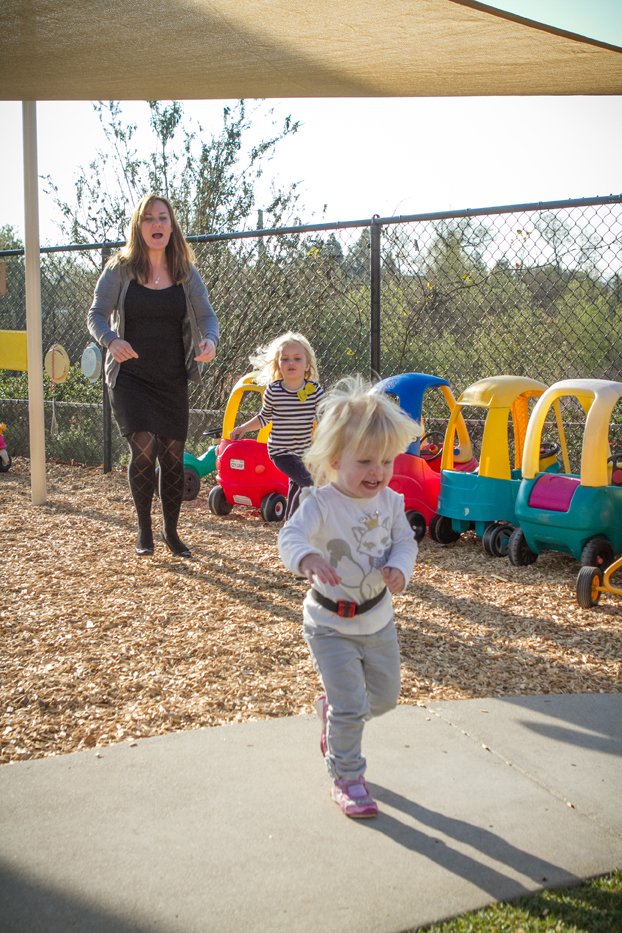Less coddling, more toddling
Assistant professor of exercise science Louise Kelly studies the physical activity of children between 12 and 36 months.

Kelly’s middle daughter, Aoibheann, 4, and youngest, Clodagh, 2 (in foreground wearing accelerometer belt), have helped out with their mother’s scholarly work as study participants.
Photo: Brian StethemDo you have any trouble finding toddlers to be in your studies?
No, and the beauty of what we do is that it’s not invasive. We’re not drawing blood; they just wear this little belt. The parents know we are not going to talk to them about weight or body fat.
When we measure the biological impedance (to estimate the amount of lean tissue), I just tell the kids it’s counting their muscles. I know it’s a white lie. I say,You’ve got a lot of muscle! You must run around and play! Hopefully, we’re planting a seed of activity.
Tell me about the little belts.
I started using these accelerometers back in ’99, as a student in Scotland. They were a little bit bigger and chunkier, and their software wasn’t as sophisticated. I was very skeptical – did they work?
So I went out and I observed. I watched about 50 different kids for hours and hours a day. Not only were the accelerometers very useful for keeping track of movement, but I learned that a lot of the old data on physical activity was just wrong.
How so?
Maybe 30 years ago, pediatric obesity used to be considered a low socio-economic-status problem. Poor people were overweight and obese, and richer people were lean and fit and healthy.
But most of the old data came from people filling out questionnaires. When I looked at the analysis of the accelerometer data, I found there was absolutely no difference in the physical activity levels between the rich and the poor kids.
The rich kids definitely participated in more structured activities. They went to ballet class, fencing class, tennis. But when you actually watched them – these were 3- to 5-year-olds – there was a lot of demonstration of technique. Yes, you need technique to get more active, but the parents were spending a lot of money on these lessons with very little physical activity being involved.
Why do you focus on toddlers now?
We’re looking at the physical activity levels of younger children because of what happens later. Between the ages of 3 and 5, children go through one of the critical periods for the development of obesity, called the adiposity rebound. The BMI percentile drops just prior to that period, and as it starts to come back up, that period of increase is called the rebound. If it goes up too high too quickly, then they’re at future risk of obesity.
Obese children rebound much earlier, and now we’re finding out that lean children – normal-weight children – are rebounding earlier as well, putting them at risk for obesity, too.
The younger we look, if we know that physical activity is one of the modifier factors, then we can try to change, so that they’re not rebounding so quickly.
How active, or inactive, are toddlers these days?
A child will spend 80 percent-plus of their waking day sedentary. Girls are worse than boys. Most people believe it happens around the teenage years, and girls do become less physically active after they hit puberty. But in actual fact, we’re showing gender differences as young as 12 months.
Isn’t the problem getting worse awfully fast? Why?
Within the last 10 years, I’d say, we’ve seen a dramatic increase in the prevalence of Type II diabetes in kids. It used to be a disease of retired people. Now, children as young as 8 and 9 have full-blown Type II diabetes. Our Hispanic, our African-American children, many of our minority children are at higher risk because of genetic predisposition.
It’s very complex. Cost of living has gone up. Parents are working two or three jobs. Access to food has decreased and fast food has become the norm. Kids start to emotionally eat because of loneliness and stress. Parents are not there, and there’s more access to TV and computer games. We’re keeping our children inside a lot more. A lot of parents that I work with have commented that they don’t know how to play with their kids, and they need some tips.
Parents are also terrified of their children being hungry, so they give in constantly. Children need structure, and if they don’t have it, they’re more likely to be overweight.
Is there any way to turn this around?
We are moving toward more interdisciplinary research that takes the whole person into account. It needs to go into the community, with culturally appropriate nutrition programs. We’re working on a grant to do that with 200-400 families in and around Ventura County.
Another reason we work with toddlers is that younger children are more compliant and susceptible to change. A teenager is not done for, obviously, but it’s easier to help the family change with a younger child than with a stroppy teenager, and they’re more open to changing as a family.
Normally, we’ve seen treatment in adolescence for diabetes and other conditions, but we do want to get in and prevent these things from happening.